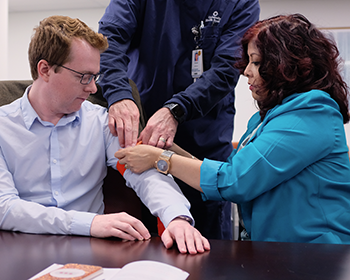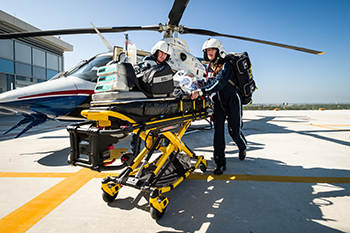Structural Empowerment
Professional Governance
Nurses at University Health play a crucial role in shaping nursing practice and patient care through their active participation in professional governance. By engaging in decision-making processes, committees and policy development, nurses have a direct impact on improving care standards, advocating for evidence-based practices and enhancing patient safety. Their involvement allows them to voice the needs and concerns of both patients and staff, ensuring that nursing practices evolve to meet the dynamic health care environment. Through professional governance, nurses can drive innovation, promote professional growth and ultimately contribute to better, more efficient patient care.
Nurses across University Health also participate in interdisciplinary decision-making groups and have been able to:
- Reduce peripheral intravenous line complications in pediatric patients
- Develop and implement a standard of care to reduce delirium in our pediatric patients
- Enhance patient experience in the perianesthesia setting by using integrative modalities before and after surgery
Maternal Transport Team Providing Patients with the Highest Level of Care
The Maternal Transport team is a continuation of the University Health Women’s and Children’s Services that dates back more than 100 years. The Maternal Transport Team provides high-risk pregnant patients with specialized, safe and quality care during ground and air transport throughout South Texas.
In late 2017, the Maternal Transport team began with a training program for nurses to transport patients to University Health by ground and air transport. The nurses simulated transport of high-risk patients inside University Health ambulances with paramedic teams. The team worked with San Antonio AirLife to develop extensive training on procedures for transport from the helipad to referring hospitals.
The program was designed to provide patients with the highest level of care by our OB/Maternal-Fetal Medicine team on arrival at our Level IV Maternal Facility 24/7. Protocols, flight physiology, collaboration of care with the experienced labor and delivery nurse, and skilled flight personnel prepared this highly qualified, specialized team. The Maternal Transport team members participated in training in the Intensive Care Unit at University Hospital. As a result, the Labor and Delivery team is able to transition high acuity patients into the Intensive Care Unit (ICU) and co-manage complicated maternal patients alongside the ICU team.
This robust program was developed through the leadership of Pat Ramsey, MD, MSPH, and team leader Allison Moreno, BSN, RNC-OB. In September 2018, the program met and exceeded expectations of high-risk patients transported from rural southwest Texas to a higher level of care at University Health. The Perinatal-Neonatal program at University Hospital, under the direction of Rebecca Terrazas, BSN, complements and promotes the team – providing multidisciplinary training to educate the nurses and physicians who provide care for pregnant women and neonates at maternal facilities throughout South Texas. Rural physicians contact our Maternal-Fetal Medicine providers for consults and/or transports, which then allows the University Health Maternal-Fetal Medicine team to begin caring for patients immediately and evaluate on-site prior to transport.
Stop the Bleed
Save a Life, Stop the Bleed
Uncontrolled hemorrhage is the leading cause of preventable death in trauma patients. An individual can die in just minutes if there is no intervention. To improve survival rates for the severely injured, the American College of Surgeons has developed Stop the Bleed, a free, hour-long class combining lecture and hands-on skills training. Participants learn the ABCs of basic bleeding control. The curriculum is designed for the general public, so no previous medical experience is needed. The goal of the campaign is to empower bystanders with the basic knowledge and skills to identify and intervene, as immediate responders, in the event of life-threating bleeding. Participants learn the use of direct pressure and tourniquet application.
Learn Lifesaving Training
University Health held its first bleeding control training in 2017. Since the launch of the program, the trauma team has instructed approximately 4,700 individuals. Classes are offered at the main campus and throughout the community for various organizations, businesses, schools and churches. Children as young as six years of age have been successfully trained in the basics of bleeding control. In 2018, Southwest Texas Regional Advisor Council (STRAC) reported 6,577 individuals received training throughout the region. University Health contributed to over half that number with 3,378 instructed. With support of the trauma surgeons and nurses who volunteer their time as instructors, the organization is able to meet the growing demand for this lifesaving training.
Get a Bleeding Control Kit
Having access to a bleeding control kit is an essential part of care of the injured patient. A basic kit includes a Combat Application Tourniquet, gloves, gauze and a marker. Individuals are instructed on how to obtain a kit for personal use. As the importance of immediate hemorrhage control in the injured patient gains attention, bleeding control kits are becoming readily available in many locations, including grocery stores and airports. Current efforts are in place to put a bleeding control kit in every classroom in the country. According to www.StopTheBleed.org, the only thing more tragic than a death is a death that could have been prevented.
Nurses Earn the DAISY Award
At University Health, exceptional care goes beyond skill—it’s about the heart and compassion that our nurses bring to every patient and their families. Nurses like Ray Anthony Perez, from 9 ACU, exemplify this commitment and embody what it truly means to be a caregiver.
A patient’s family shared Ray’s remarkable journey toward earning the Daisy Award recognition. The patient, a U.S. Army Colonel and combat veteran, faced the unexpected challenges of an extremely rare liver cancer and a subsequent transplant. Throughout this stressful and life-changing experience, Ray stood as a pillar of support for the patient and his family. He cared for his patient with sincerity and dedication, treating him as though he were his own family member.
A fellow health care professional with 28 years of nursing experience described Ray’s care as “above and beyond.” From providing comfort and laughter to listening intently and ensuring the patient felt respected and valued, Ray’s compassionate approach transformed his patient’s experience during an incredibly difficult time.
It’s nurses like Ray—those who embody skill, compassion and connection—that inspire all of us in health care to strive for excellence. We are proud to celebrate and recognize outstanding individuals like Ray through the Daisy Award, honoring the extraordinary difference they make in the lives of patients and families.
Pediatric Transport
What is Pediatric Transport?
Pediatric Transport was launched in 2013 to accommodate the growing medical ICU population and the return of the Pediatric Cardiac program to University Health. The team transports patients requiring specialized services or higher level of care from clinics, freestanding ERs and hospitals to University Hospital.
Pediatric specialty teams are associated with improved outcomes and fewer unplanned, adverse events during transport. Unplanned adverse events include airway-related events, cardiopulmonary arrest, sustained hypotension and loss of essential IV access. One study showed greater mortality among children transported by a non-specialized team versus a pediatric team (23% to 9%).
Pediatric Transport is comprised of RNs and RRTs who are experienced in pediatric critical care. Because the team cares for patients from birth to young adults, all transport specialists have certification in many areas. To maintain skills and knowledge, transport specialists attend a Critical Care Skills Lab annually, perform at least three intubations quarterly and participate in frequent simulations. Specialists also work shifts in the PCCU, PICU and Pedi Emergency Department.
While not on transport, the team is available to assist in the pediatric units. They place IVs, draw labs, assist with post-ops, assist with admissions and discharges, provide respiratory treatments and other tasks. The team also responds to pediatric code blues, rapid responses, pedi priority 1s and pediatric level 1 and alpha 1 traumas.
Community Outreach
Continued outreach and outreach education increases referrals from local and regional facilities, and builds relationships with referring physicians and leadership at those facilities. Follow-up visits give a consistent message, answer questions and introduce our physicians. We also offer outreach education on Sepsis in Pediatrics, Pediatric Respiratory Illnesses and Pediatric Basics. The team has taught in Eagle Pass, Laredo, Del Rio and Fredericksburg.
Marketing efforts include hosting tables at conferences, fairs and other health events to promote Pediatric Transport and all of University Children’s Health services. At the Teddy Bear Clinic hosted by Community First Health Plans (CFHP) at the DoSeum, 1,100 visitors received our message and 500 teddy bears got a free check-up.
Our Priorities
The priority of the team is transport. Often, referring facilities that don’t offer pediatric services do not have the resources to care for critically ill or injured children, so we must reach our patients quickly. Our goal mobilization time is under 20 minutes. Critical steps must be completed to initiate and prepare for the transport. The team secures appropriate transport (ground, rotor-wing, fixed-wing), taking into consideration weather conditions, patient acuity, patient’s potential to deteriorate, distance and the referring facility’s ability to stabilize the patient. The team sets up the stretcher or flight board for the size and acuity of the patient, and retrieves needed medications.
At the referring facility, the team acts as a mobile ICU to stabilize the patient for transport and initiates protocol-based and physician-ordered interventions. En route, patchy cellular service can prevent the team from phoning for physician guidance, thus the two specialists on each transport rely on teamwork and training.
Our Goals
Quality care is crucial to great patient outcomes. Goals in 2018 included zero unplanned dislodgements of essential lines/tubes, 100% follow-up phone calls to referring physicians and less than 20 minutes of mobilization time for unscheduled ground transports. The team achieved 100% follow-up phone calls in the last 6 months of 2018. By December 2018, our mobilization time for unscheduled ground transports was 19 minutes, improved from 49 minutes in January 2018. In 2019, the focus is on improving our IV success rate and continuing a goal time of less than 20 minutes for unscheduled ground transports.


